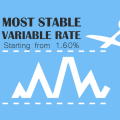
It’s time for you to buy your new property. You’ve worked out your finances. You’ve done your market research, and a couple of great properties have caught your eye. You head to your bank to apply for a loan, but instead you unwittingly get caught up in the flurry of choices put in front of you. Welcome to the world of Home Loan financing (& re-financing).
To even seasoned professionals, choosing the “best” (i.e. lowest interest rates) Home Loan Package is tough. If you are a first-timer selecting your first loan package, this might be the biggest decision in your life. There are countless loan packages available in the market. Choosing the “wrong” option may cause you thousands of dollars if you’re lucky. For some, this can mean missing out on mortgage repayments and losing their property.
This guide has been compiled to give you an overview of the key factors that you should consider when choosing a home loan package – SIBOR, SOR, FDR, FIXED, Lock-in Period.
If you’ve noticed in the previous paragraph, “best” and “wrong” are in inverted commas. Do note that there is no “right” or “wrong” option when choosing a home loan package. Interest rates are time-sensitive, and can change over the duration of your loan. Since there’s no way to accurately predict the future, there will not be a loan package which is definitely superior to the others.
Ready? Let’s begin!
WHAT DOES SOR, SIBOR, FDR & Fixed STANDS FOR?
In general, loans can be classified into three main categories: Floating (SOR, SIBOR), Fixed Deposit-Linked Rates (FDR) and 100% Fixed.
SOR stands for the Swap Offer Rate. It is loosely pegged to the US Federal interest rates (you can track this via news articles on credible websites like CNN, Financial Times etc.). Because it deals with exchange rates, it is more volatile than SIBOR and FDR rates.
SIBOR stands for the Singapore Inter-Bank Offered Rate. It changes daily and refers to the interest rate at which banks lend money to each other. Thomson Reuters compile the rates from all 17 banks in Singapore every day. They remove the upper and lower quartile and take the average of the remaining rates as that day’s SIBOR rate. The SIBOR rate is dependent on the amount of cash reserves that Singapore Banks have. It is, in general, more volatile than FDR rates.
FDR stands for Fixed Deposit-linked Rate, and is set by the bank. It is the interest rate that you as a saver will get if you deposit money in the bank. A loan rate package typically offers an interest rate of, for example, FDR+0.6%. At the very core of its operations, banks earn money by charging a higher interest rates for borrowers (loans) than for savers (deposits). The 0.6% additional charge is hence the bank’s profit margin. FDR rates may change, if and only if the bank changes their fixed-deposit interest rates. However, if banks increase their FDR, they would have to pay more to savers as well. Thus, FDR tends to be relatively more stable than SOR or SIBOR. There are various names for this in different banks, for instance DBS uses “Fixed-deposit Home Rate (FHR)”, OCBC uses “Fixed Deposit Mortgage Rate (FDMR)” and UOB simply uses “Board Rates”.
Fixed rates are, you guessed it, fixed rates. They are entirely independent of the economy and/or bank policy, and are 100% fixed.
UNDERSTANDING SIBOR & ITS IMPLICATION
Banks offer SIBOR rate packages in several forms. Typically, these include the one-month SIBOR (average rate for that month), three-month SIBOR (average rate for the past three months) and twelve-month SIBOR (average rate for the past twelve months).
Of course, one-month SIBOR rates will be more volatile than longer term SIBOR rates, as they are aggregated only over a month. A twelve-month SIBOR rate, aggregated over twelve months, is less volatile.
Still unclear? Here’s an example:
| Year 2017 | Jan | Feb | Mar | Apr | May | Jun |
| SIBOR | 1% | 1% | 2% | 2% | 3% | 5% |
| 1-month SIBOR | 1% | 1% | 2% | 2% | 3% | 5% |
| 3-month SIBOR | 1% | 1% | 1.33% | 1.66% | 2.66% | 3.33% |
| 12-month SIBOR | 1% | 1% | 1.083% | 1.167% | 1.33% | 1.833% |
*For simplicity, we assume SIBOR rates change monthly instead of daily, and that SIBOR rates remain constant at 1% throughout year 2016.
Imagine SIBOR have been constant at 1% from 2016 through to February 2017. Then, in March 2017, SIBOR increases to 2%. Remember, 3-month and 12-month SIBOR rates refer to the average SIBOR rates over the past 3 and 12 months respectively.
For the month of March:
The one-month SIBOR automatically increases to 2% as well, because 2% is the SIBOR for that month of March.
![]()
However, the three-month SIBOR only increases by 0.33%, as it is the aggregate of the past 3 SIBOR rates.
![]()
Now, if you extrapolate the data points for the twelve month SIBOR, you will get 11 months of 1% (Apr 16 to Feb 17), and one month of 2% (Mar 17).

This simple mathematics applies for all SIBOR calculations, try it yourself and check it against the final percentage provided above J
Wow! The 12-month SIBOR rate is so much lower; it must definitely be advantageous to choose it, right? Unfortunately, it isn’t that simple. The converse of this is also true. If interest rates fall over the course of your loan, the 12-month SIBOR rate will also be slower to respond, and hence be higher than the 1-month SIBOR rate.
Also, the mark-ups for each case is different, and dependent on the state of the economy.
If SIBOR rates are expected to fall / remain low, 1-month SIBOR mark-ups may be higher than longer term ones. For example:
A Residential Property Loan with 1-Year penalty period may look something like this:
*penalty periods will be discussed later
1-Month SIBOR: 3-Month SIBOR:
Year 1: 1-Month SIBOR + 0.50% Year 1: 3-Month SIBOR + 0.35%
Year 2: 1-Month SIBOR + 0.60% Year 2: 3-Month SIBOR + 0.45%
Year 3: 1-Month SIBOR + 0.70% Year 3: 3-Month SIBOR + 0.55%
Thereafter: 1-Month SIBOR + 0.95% Thereafter: 3-Month SIBOR + 0.95%
Whichever is better will depend on the changes (positive or negative) in SIBOR rates, US Fed rates, and, in the bigger picture, how the world economy is doing.
UNDERSTANDING FIXED DEPOSIT-LINK RATE & ITS IMPLICATION
Banks often offer FDR loan packages pegged to their Fixed-deposit Rate. If you’ve had experience with fixed-deposits before, you may know that there are various fixed-deposit rates in the market.
Generally, the longer your fixed-deposit term is, the higher your interest rate. For example, an 18-month (18M) fixed-deposit will earn less interest (lower interest rate) per month than a 36-month (36M) fixed-deposit rate. This is because in the 36M scenario, your money is locked in the bank for a longer period of time, leaving you with less liquidity and financial flexibility compared to the 18M deposit.
Similarly, loan packages embrace 36M and 18M interest rates and may allow you to choose between these rates. Of course, as the 36M rate is higher than the 18M rate, it will have a lower mark-up.
SIBOR OR FDR
*For the purpose of this article, floating exchange rates will be grouped together. Explanations for SIBOR rates, and floating rates in general, apply to SOR rates as well. Fixed exchange rates will also be grouped together. Explanations for FDR rates apply to fixed rates as well.
SIBOR rates tend to be more volatile than FDR rates, and hence individuals with a higher risk appetite tend to prefer SIBOR rates. In today’s slow economy, interest rates are low worldwide. Hence, while SIBOR may be more volatile than FDR, they tend to be slightly lower. However, there is no guarantee that SIBOR rates will stay low over the course of your loan, and volatile interest rates may cause financial uncertainty – your monthly mortgage payments may fluctuate from month to month.
Similar to buying insurance, individuals who opt for FDR essentially pay a premium for stability. You pay slightly more now, but are not exposed to the volatility of the SIBOR market. This way, you can have a clear financial plan with steady mortgage payments.
In short, if you prefer certainty over risk in today’s dynamic economy, you may opt for the FDR packages instead of the SIBOR ones. Otherwise, if you are confident that the economy wouldn’t pick up so soon, SIBOR would make a better choice for you.
LASTLY, LOCK-IN PERIOD
Now that you’ve got the general idea of loan packages, let’s discuss another key factor which will influence your decision: the lock-in period.
The lock-in period refers to the period during which you will be charged a penalty if you were to reprice your loan (i.e. switch to another loan package). Loan deals typically come with penalty periods of 0, 1, 2 or 3 years.
If you’ve browsed through loan packages offered by banks, you would have noticed that interest rates increase exponentially over the years. Interest rate hikes can happen as early as the second year. Or perhaps, after a year, the economy did not perform as you predicted, and you decide that you are not getting the best deal with your current package. These are all valid reasons for you to reprice your loan, and here’s where lock-in periods come in.
Packages with shorter lock-in period gives you more flexibility, as you can reprice your loan once your lock-in period is over. You can then choose again from the banks available packages, or simply to stick to your existing package. Of course, you will be charged administrative fees such as repricing fees ($500-$800), and/or legal fees & early redemption fees, if you intend to refinance (switch loan package to one from another bank) instead of reprice (switching loan packages within the same bank).
If you’re confident in your prediction of the economy, you might prefer a package with a longer lock-in period. If not, a shorter lock-in period would offer you the chance to refinance (or, reprice) your loan in a shorter period of time.
Do hope that you’ve got a better understanding of the Home Loan Packages on the table after reading this article. As always, if you have any questions or feedback, do write to us at hello@realila.sg. We love to hear from you.
USEFUL TOOL: PROPERTY BUDGET CALCULATOR




